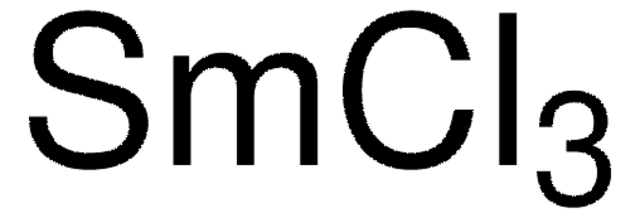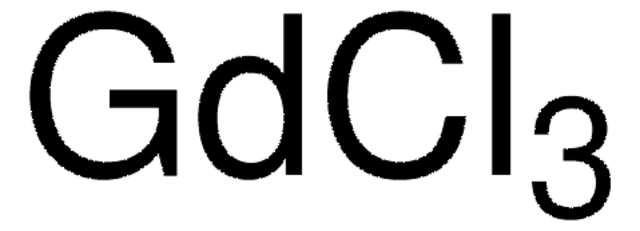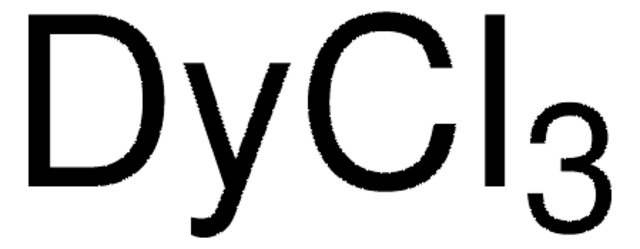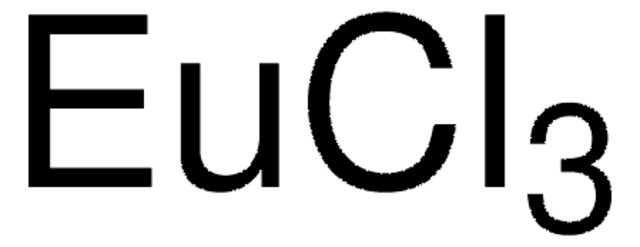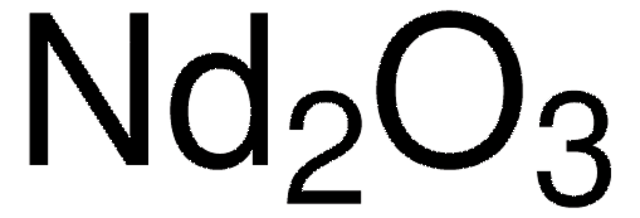449946
Neodymium(III) chloride
anhydrous, powder, ≥99.99% trace metals basis
Sinónimos:
Neodymium chloride, Neodymium trichloride
About This Item
Productos recomendados
grado
anhydrous
Nivel de calidad
Ensayo
≥99.99% trace metals basis
Formulario
powder
idoneidad de la reacción
reagent type: catalyst
core: neodymium
impurezas
≤100.0 ppm Trace Rare Earth Analysis
mp
784 °C (lit.)
densidad
4.134 g/mL at 25 °C (lit.)
cadena SMILES
Cl[Nd](Cl)Cl
InChI
1S/3ClH.Nd/h3*1H;/q;;;+3/p-3
Clave InChI
ATINCSYRHURBSP-UHFFFAOYSA-K
¿Está buscando productos similares? Visita Guía de comparación de productos
Categorías relacionadas
Aplicación
- Fluorine-free organic electrolytes for the stable electrodeposition of neodymium metal: This study investigates alternative electrolytes for neodymium metal deposition, aiming for more sustainable battery manufacturing processes (Geysens et al., 2023).
- The use of artificial neural network (ANN) for modeling adsorption of sunset yellow onto neodymium modified ordered mesoporous carbon: Highlights the use of Neodymium(III) chloride in advanced adsorption processes for environmental applications, modeling the interactions using ANN (Ahmad et al., 2020).
Para utilizar con
Palabra de señalización
Warning
Frases de peligro
Consejos de prudencia
Clasificaciones de peligro
Eye Irrit. 2 - Skin Irrit. 2 - STOT SE 3
Órganos de actuación
Respiratory system
Código de clase de almacenamiento
11 - Combustible Solids
Clase de riesgo para el agua (WGK)
WGK 2
Punto de inflamabilidad (°F)
Not applicable
Punto de inflamabilidad (°C)
Not applicable
Equipo de protección personal
dust mask type N95 (US), Eyeshields, Gloves
Elija entre una de las versiones más recientes:
¿Ya tiene este producto?
Encuentre la documentación para los productos que ha comprado recientemente en la Biblioteca de documentos.
Los clientes también vieron
Artículos
The rare earth elements impact nearly everyone in the world. All of the people living in advanced technological countries and almost all those living in third world countries utilize the rare earths in their everyday living—the car that one drives (gasoline is refined from oil using rare earth catalysts and catalytic converters reduce the polluting emissions from the automotive exhaust), watching the news on TV (the red and green colors in TV screens), the telephones and computers we use to communicate (the permanent magnets in speakers and disc drives), just to name a few examples.
Global Trade Item Number
| Número de referencia del producto (SKU) | GTIN |
|---|---|
| 449946-25G | 4061838139993 |
| 449946-5G | 4061832323534 |
Nuestro equipo de científicos tiene experiencia en todas las áreas de investigación: Ciencias de la vida, Ciencia de los materiales, Síntesis química, Cromatografía, Analítica y muchas otras.
Póngase en contacto con el Servicio técnico

